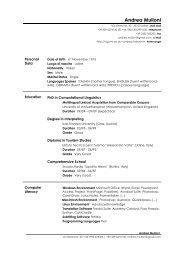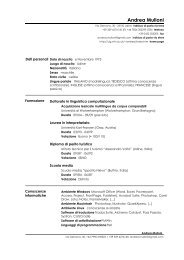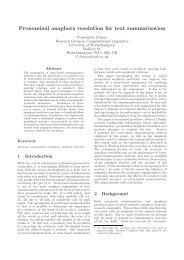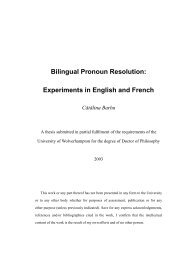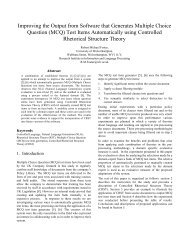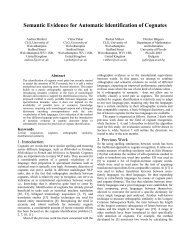Design and development of a concept-based multi ... - Citeseer
Design and development of a concept-based multi ... - Citeseer
Design and development of a concept-based multi ... - Citeseer
You also want an ePaper? Increase the reach of your titles
YUMPU automatically turns print PDFs into web optimized ePapers that Google loves.
Shiyan Ou, Christopher S.G. Khoo <strong>and</strong> Dion H. Goh<br />
single-word terms<br />
2-word terms<br />
3-word terms<br />
4-word terms<br />
5-word terms<br />
More than 5-word<br />
terms<br />
Main <strong>concept</strong> at<br />
the top level<br />
undergraduate<br />
student<br />
black<br />
undergraduate<br />
student<br />
adjustment <strong>of</strong> black<br />
undergraduate student<br />
college adjustment <strong>of</strong> black<br />
undergraduate student<br />
Fig. 2. A cluster tree containing five term chains.<br />
student<br />
Latino student<br />
Latino students’ academic<br />
achievement<br />
college<br />
student<br />
College students’ future<br />
career choices<br />
characteristic <strong>of</strong><br />
student<br />
individual<br />
characteristic <strong>of</strong><br />
student<br />
Concepts at the<br />
second level<br />
Full <strong>concept</strong>s<br />
behavior <strong>of</strong><br />
student<br />
delinquent<br />
behavior <strong>of</strong><br />
student<br />
relationships <strong>and</strong> four second-order relationships were found <strong>and</strong> listed in Table 3. The secondorder<br />
relationship refers to the relationship between two or more variables influenced by a third<br />
variable. For example, a moderator variable influences the relationship between two variables,<br />
whereas a mediator variable occurs between two other variables. A total <strong>of</strong> 126 relationship patterns<br />
were constructed representing different surface expressions <strong>of</strong> the same types <strong>of</strong> relationship.<br />
The different surface expressions for the same type <strong>of</strong> relationship can be normalized using a<br />
predefined st<strong>and</strong>ard expression. If two variables in a relationship are distinguished in the text as<br />
independent variable (IV) <strong>and</strong> dependent variable (DV), two st<strong>and</strong>ard expressions are provided by<br />
regarding each <strong>of</strong> the variables as the main variable. For each st<strong>and</strong>ard expression, three modalities<br />
are h<strong>and</strong>led – positive, negative or hypothesized. For example, for a cause–effect relationship with<br />
the independent variable as the main variable, the three modalities are:<br />
• Positive: There was an effect on a .<br />
• Negative: There was no effect on a .<br />
• Hypothesized: There may be an effect on a .<br />
Table 3<br />
Nine types <strong>of</strong> semantic relationship<br />
ID First-order relationship Second-order relationship<br />
1 Cause–effect relationship Second-order cause–effect relationship<br />
2 Correlation Second-order correlation<br />
3 Interactive relationship Second-order interactive relationship<br />
4 Comparative relationship Second-order comparative relationship<br />
5 Predictive relationship −<br />
Journal <strong>of</strong> Information Science, XX (X) 2007, pp. 1–19 © CILIP, DOI: 10.1177/0165551507084630 9



